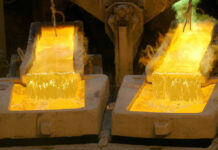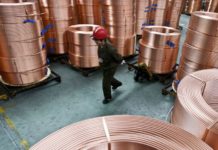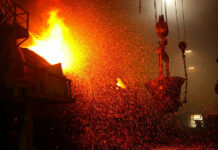
[miningmx.com] — BHP Billiton, the world’s largest miner, on Wednesday gave an upbeat outlook for commodities, shipping half its record quarterly production of iron ore to China, and setting the stage for higher 2010 output.
The company highlighted hefty price recoveries across key commodities, from iron ore and copper to aluminium and nickel, in the December quarter, led by strong sales to China as well as inventory rebuilding in developed economies.
Half the 32.45 million tonnes of iron ore BHP produced from mines in Australia and Brazil in the quarter went to China, where steel mills have shown a preference for imported rather than domestic ore, because it contains more iron.
Official data due out on Thursday is expected to show China returned to double-digit economic growth in the fourth quarter — good news for BHP Billiton as it would reflect healthy underlying demand for energy and resources by its top customer.
“Government stimulus measures appear to have supported a gradual return to normalised global trade, albeit from a low base, and most key indicators across the developed economies showed improvement,” it said.
BHP Billiton added a note of caution, saying commodity prices could remain volatile in the near term as rich economies withdraw stimulus funding, but analysts called it a strong showing, underlining their forecasts for a further run-up in prices. “It’s an impressive production scorecard,” Bank of America Merrill Lynch said in a client note.
BHP Billiton’s production of iron ore, the main material used to manufacture steel, leapt 11 percent in the quarter from a year earlier, mirroring strong production data from rivals Rio Tinto and Vale. BHP Billiton is third-largest of the three major producers.
By tapping new deposits in Australia’s rich Pilbara iron belt as part of a multi-year “rapid growth project”, BHP Billiton’s iron ore production is earmarked to grow 36 percent to 155 million tonnes this year and a further 50 million by end-2011.
BHP Billiton is not alone in beefing up its iron ore business.
Next year Rio Tinto wants to lift iron ore mine capacity 6 percent to 230 million tonnes, followed by a much bigger jump to 300 million in five years.
And Fortescue Metals Group aims to lift annual production to 45 million from 38 million this year.
In Brazil, Vale this week said it was heading toward record iron ore exports this year as it runs its mines near their 310 million -tonnes-per-year maximum.
Still, a global supply deficit of 58 million tonnes looms this year, possibly swelling to 108 million tonnes in 2011, according to Bank of America Merrill Lynch.
Such insatiable appetite for iron ore is driving producers to ship more onto the spot market, where buyers are willing to pay twice the price paid under long-term contracts that have traditionally governed the market.
IRON ORE PRICES
Contract iron ore prices under negotiation with steel mills are forecast by analysts to rise by as much as 50 percent this year if a settlement is reached after recoiling in 2009/10.
Steel prices are already rising due to higher raw materials costs and were set to keep going up in step with iron ore.
For the half-year ended December, BHP said 46 percent of its Australian iron ore shipments were sold on shorter-term reference pricing, or spot, versus only 30 percent in the previous half. This highlights a trend across the industry as Chinese steelmakers raise production and could weaken the hand of steel mills negotiating 2010/11 benchmark contracts.
India sold almost 100 million tonnes of ore to China on a spot basis last year, or about two-thirds of BHP Billiton’s total projected output for 2010.
Spot prices are just above $129 C.I.F (Cost, Insurance and Freight), according to the Steel Index against contract prices valid until March 31 of around $60 a tonne.
COPPER
Copper output, as expected, fell 11 percent in the December quarter after an accident at BHP’s Olympic Dam mine in Australia. Olympic Dam has run at a quarter of capacity since the accident in October, which led to the closure of its main haulage shaft. The mine lost 20,000 tonnes production in the December quarter. It is scheduled to return to normal by the end of March. Industrial action at the company’s Spence mine in Chile cut production by a further 28,000 tonnes.
Copper prices have risen over 130 percent in the last year. Some analysts are projecting a supply deficit later in 2010, aggravated by the production shortfalls in Australia and Chile and only partially offset by higher output from BHP’s majority-owned Escondida mine.
Nickel production rose 20 percent, owing to a stronger output at BHP’s Australian mines, lifting its exposure to rising prices in the sector despite a growing global supply surplus.
London Metal Exchange nickel is fetching about $19,300 per tonne versus $13,000 a year ago.
BHP firmed more than 1 percent after the production report before easing to stand at A$43.41, up 0.2 percent, by 0604 GMT, outperforming the wider market.
“All in all, Rio packed a bigger punch but came from a lower base than BHP, which weathered the global financial crisis a lot better,” said DJ Carmichael & Co mining analyst James Wilson.











